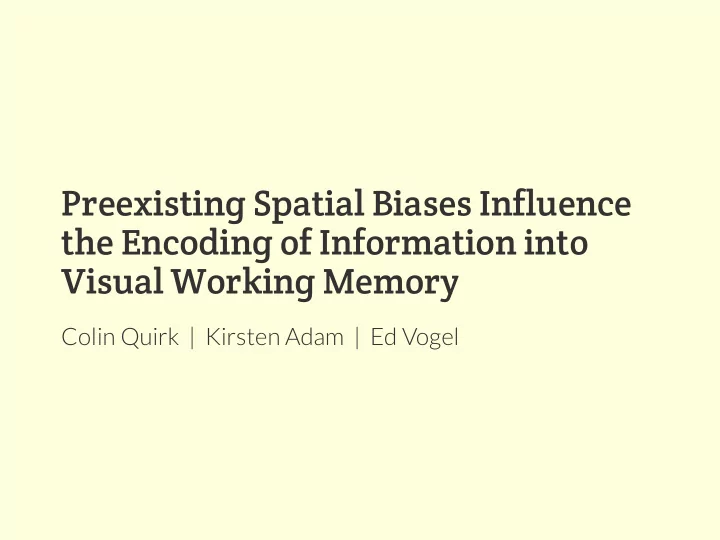

Preexisting Spatial Biases Influence the Encoding of Information into Visual Working Memory Colin Quirk | Kirsten Adam | Ed Vogel
Introduction Which items are stored when a display contains more information than you can remember?
Experiment 1 Procedure n: 121 trials: 540 Data published in Xu, Adam, Fang & Vogel (2018)
Experiment 1 Results
Top Accuracy – Bottom Accuracy Right Accuracy – Left Accuracy
Stimulus Properties Brady and Tenenbaum (2013) found that subjects are consistent in their performance when viewing the exact same change detection displays.
Experiment 2 Results Random Arrays Identical Arrays n = 121 | trials = 540 n = 279 | trials = 120
Top Accuracy – Bottom Accuracy Right Accuracy – Left Accuracy
Capacity Differences
Experiment 3 Results All Quadrants Forced Hemifield n = 281 | observations = 720 n = 110 | observations = 720 *** *** n.s. n.s. Accuracy (%) Accuracy (%)
Top Accuracy – Bottom Accuracy Right Accuracy – Left Accuracy
Selection Bias Umemoto et al. (2010) found that participants can implicitly learn where changes in a display are more likely to occur Experimental Bias n = 75 | trials = 1200
Experiment 4 Results Control Differences *** *** * n.s.
Conclusion Over multiple experiments (470340 observations), we have repeatedly observed the same pattern of performance differences across quadrants. Preliminary results seem to suggest this is due to a bias in selection, as opposed to something about stimulus properties or capacity Complete working memory models need to account for these existing biases when attempting to estimate capacity
Recommend
More recommend